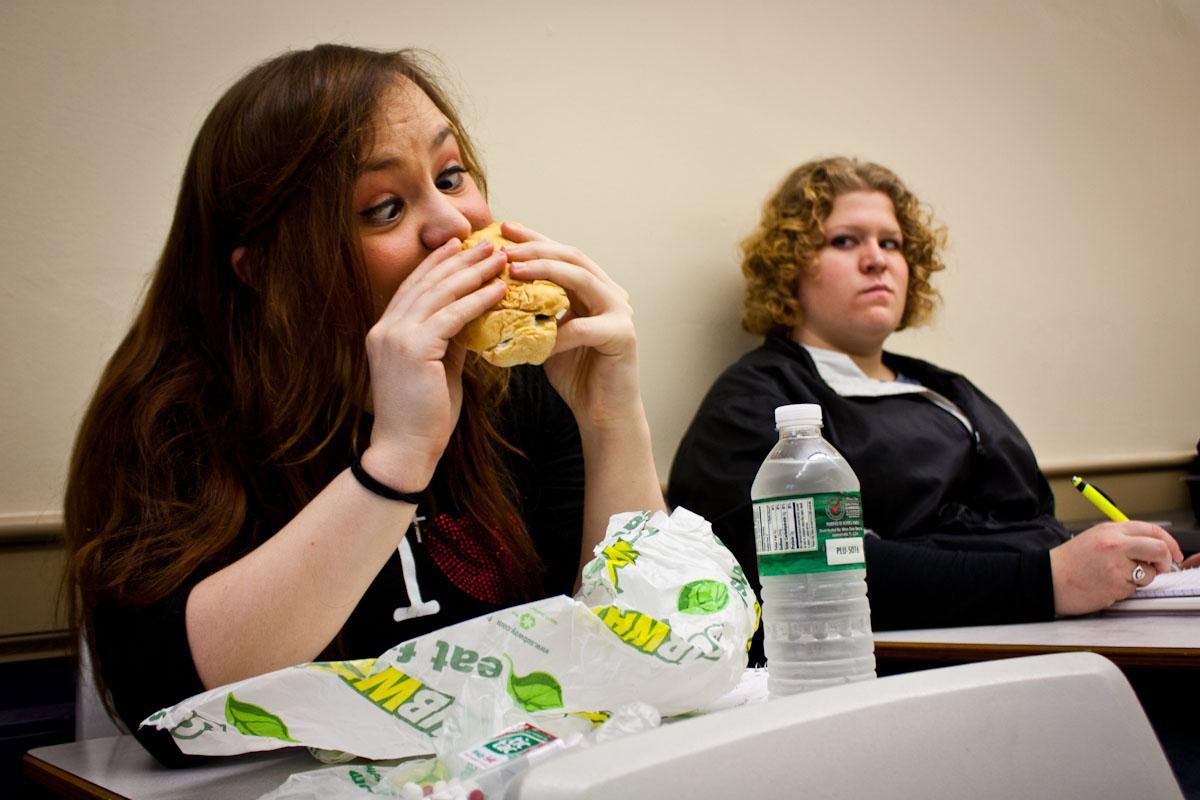Every college student has had to lug his or her lunch into class at least once. The stress of a hectic schedule in college can make anyone hungry. Much mid-lecture munching may go unnoticed, but there’s always the chance one student lacking in snacking savvy could derail the class, distracting students and faculty members alike.
Digital arts sophomore Jessica Sprick said eating in class is a major faux-pas. She said it tends to disrupt class, recalling in particular a story from a friend who was confronted by a teacher for eating sushi.
“The teacher asked my friend a question, then said ‘Maybe if you weren’t eating in class, you would know the answer,’” Sprick said.
This isn’t to say all students feel eating in class is distasteful. Graphic design junior Sara Granados said she has never been distracted by someone eating in class. She said most of her graphic design and art classes are small and laid back enough that there are always students eating.
Granados said the only food she would find inappropriate to eat in class would be those that make noise, like potato chips.
It’s true that loud foods are more likely to be noticed by a broader audience, but how incognito could strong-smelling foods be?
“I ate a tuna fish sub in class one day because I was running late. I felt really self-conscious about it. I kept thinking, ‘Are people grossed out by the smell of this sandwich?’” said English senior Jessica St. John.
Unnerved by the feeling that everyone was watching her eat, St. John said she ate quickly and took care to avoid dripping anything.
St. John said she makes allowances for the fact that people may not have time to eat outside of class, but everyone must be adults and realize how distracting or offensive their choice in food may be. She suggested eating a breath mint directly after consuming something smelly and avoiding the practice of eating in class if chewing with a closed mouth is a problem.
As for professors, St. John said she has never had one call a student out for eating. However, she points out that most of her professors have been “highly distraction-intolerant,” and many students didn’t dare risk it.
Frank A. Anselmo, assistant professor of the French department, seems to fit this description. Anselmo said he could not believe the gall of one student bringing an entire lunch from Subway to his class — one in which the student would have to speak coherent French to earn her participation grade — and rudely not having enough to share with the rest of the students.
“So I told her that my classroom was not a café and asked her to put her food away,” Anselmo said.
On the other hand, Art History Professor Mark Zucker said he rarely notices his students chowing down, if they do at all. When he does notice, he said he usually remarks, “I know my classes are picnics, but I’d still prefer it if you’d refrain from eating.”
About 15 to 20 years ago, Zucker said it wasn’t uncommon to find both students and professors smoking in class. In his art history lectures, the smoke created a bigger distraction than food could, especially when wafting smoke would produce weird visual effects on the slide projector.
The more serious problem today, Zucker said, lies in students bringing beverages to class. He said students tend to leave their cups of coffee or soft drinks on the floor of classrooms to be knocked over, resulting in unpleasant messes and lasting stains.
Although most of the opposition classmates and professors have to conspicuous snackers is rooted in their distraction, the rest could be attributed to jealousy that they can’t follow suit. As Sprick said about one repeat offender in her night class, “… His really fragrant Panda Express made everyone hungry.”
Anselmo is also more tolerant about students eating in class if they share. He recalled once having a student who, upon Anselmo’s request, milked his own cows the night before and brought enough of the refrigerated product to share with the whole class.
Anselmo insisted that it is the best milk he has ever tasted.




